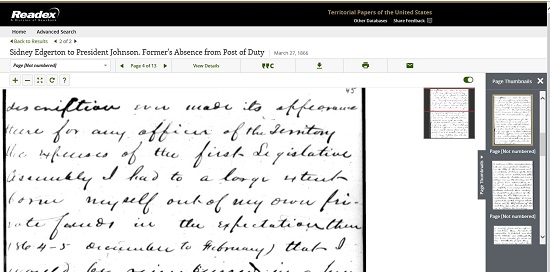What makes a primary source interface a GREAT interface?
When Readex recently posed this question to a wide range of researchers, we heard four crucial things:
- Modern styling—researchers want primary source databases that are visually engaging and feel “right”
- Ease of use—both experts and novices want their path to primary sources to be simple and intuitive
- Speed!—software must search quickly, deliver relevant results in a blink, and rapidly display large images
- Flexible tools that optimize content use and which map to common user needs and workflows.
With this feedback front and center, Readex has been busy making fresh improvements to its interfaces.
Two months ago I had the pleasure of announcing a major overhaul of the America’s Historical Newspapers and World Newspaper Archive platform. User reaction has been extremely positive, and it’s gratifying to see more usage and better research outcomes.
We’ve already saved many users a substantial amount of time, too, by introducing a number of efficiencies to the interface.
Of course the work is never done, nor should it be. It’s important to stay abreast of needs and to make continuous improvements to our interfaces and services.
During the past several months we’ve been focusing on the fourth bullet above—“flexible tools that optimize content use.” Much of our effort has focused on enhancing the “document view” experience (sometimes called the “image viewer”) in our products. This is where users encounter the actual primary source in image form.
Throughout 2018, we met with users and asked them about the image viewer. Here’s what they said:
- The size of the viewing space has been growing—which we appreciate—but can you make it even bigger?
- Can you make it easy to search within documents from the image viewer itself, especially for historical newspapers?
- Can you help us access, print, and download perfect citations?
- Can you display thumbnail images of documents in the viewer, enabling us to scroll quickly through many pages?
The answer to all of these requests: YES WE CAN.
Today’s new image viewer addresses all of the needs described above, and more besides.
The new tools are designed to be intuitive and efficient, and we’ve laid them out on toolbars to reveal their value and availability instantly. No more “how does this work” reactions from users—that’s the objective!
Myself, I am most proud of the thumbnail viewer. For newspapers, this is invaluable. It makes it possible for users to see the page that precedes the page being viewed, the page that follows, and all surrounding pages at a glance. This helps users in many ways, principally by revealing the context of the content within its surroundings. This is crucial for interpretation and analysis.
The thumbnail viewer also lets users navigate a single multi-page document from a single screen. For manuscript-based collections like Territorial Papers of the United States, this is a major enhancement. Manuscripts can be tricky to work with (they tend not to follow the structure of books or newspapers). Viewing many pages at once, in context, helps relieve this concern and makes the content-encounter more effective and more rewarding.

And Readex is not done yet!
Coming in summer 2019:
- Personal user accounts will let users save their work and return to it
- Ability to email multiple documents at once, saving time and providing access to content when and where it is needed
- Much-requested access to Google Drive.
Coming later in 2019:
- Thumbnail viewing for nearly every Readex product. Today “thumbnails” are available through Readex Historical Newspapers and for a handful of other collections, including, for example, Territorial Papers of the United States and Nineteenth-Century American Drama.
Stay tuned!



